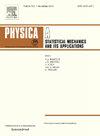CardiacPINN: A Physics-Informed Neural Network with multi-head attention for non-invasive assessment of cardiac function
IF 2.8
3区 物理与天体物理
Q2 PHYSICS, MULTIDISCIPLINARY
Physica A: Statistical Mechanics and its Applications
Pub Date : 2025-06-09
DOI:10.1016/j.physa.2025.130717
引用次数: 0
Abstract
Accurate and rapid assessment of left ventricular (LV) contractility is crucial for managing cardiovascular diseases, yet current methods are limited by invasiveness or sparse data. To address these challenges, this study introduces CardiacPINN, a Physics-Informed Neural Network (PINN) designed for fast, non-invasive, and physiologically consistent estimation of LV contractility. CardiacPINN utilizes a closed-loop lumped-parameter cardiovascular model with five compartments to capture pressure–volume interactions and integrates multi-scale Fourier features, hierarchical self-attention, and an adaptive physics-constrained loss balancing strategy to enforce hemodynamic laws and ensure numerical stability. Evaluated using synthetic datasets generated via Latin Hypercube Sampling and experimental swine data, CardiacPINN demonstrated a convergence rate up to 76% faster than a baseline PINN on swine datasets and achieved a root-mean absolute error one order of magnitude lower in key compartments like the vena cava and peripheral arteries. The model accurately reproduced pressure–volume loops in both synthetic and real swine data, the quantitative range of R values achieved on the swine data for both LV pressure (0.88–0.99) and LV volume (0.59–0.97), effectively capturing contractility changes induced by dobutamine. These results indicate that CardiacPINN offers robust and efficient estimation of LV contractility across various physiological conditions, paving the way for real-time cardiac monitoring and personalized healthcare.
CardiacPINN:一个具有多头关注的物理信息神经网络,用于无创心功能评估
准确、快速地评估左室(LV)收缩力对心血管疾病的治疗至关重要,但目前的方法受到侵入性或数据稀疏的限制。为了应对这些挑战,本研究引入了CardiacPINN,这是一种物理信息神经网络(PINN),旨在快速、无创、生理上一致地估计左室收缩力。CardiacPINN利用闭环集总参数心血管模型与五个室来捕获压力-体积相互作用,并集成了多尺度傅立叶特征、分层自关注和自适应物理约束损失平衡策略,以执行血流动力学定律并确保数值稳定性。使用拉丁超立方采样和实验猪数据生成的合成数据集进行评估,CardiacPINN的收敛速度比猪数据集上的基线PINN快76%,并且在腔静脉和外周动脉等关键腔室中实现的根均值绝对误差降低了一个数量级。该模型准确再现了合成猪和真实猪数据的压力-容积循环,猪数据的左室压力(0.88-0.99)和左室容积(0.59-0.97)的R2值均达到定量范围,有效捕获了多巴酚丁胺引起的收缩性变化。这些结果表明,CardiacPINN在各种生理条件下提供了可靠有效的左室收缩力估计,为实时心脏监测和个性化医疗保健铺平了道路。
本文章由计算机程序翻译,如有差异,请以英文原文为准。
求助全文
约1分钟内获得全文
求助全文
来源期刊
CiteScore
7.20
自引率
9.10%
发文量
852
审稿时长
6.6 months
期刊介绍:
Physica A: Statistical Mechanics and its Applications
Recognized by the European Physical Society
Physica A publishes research in the field of statistical mechanics and its applications.
Statistical mechanics sets out to explain the behaviour of macroscopic systems by studying the statistical properties of their microscopic constituents.
Applications of the techniques of statistical mechanics are widespread, and include: applications to physical systems such as solids, liquids and gases; applications to chemical and biological systems (colloids, interfaces, complex fluids, polymers and biopolymers, cell physics); and other interdisciplinary applications to for instance biological, economical and sociological systems.

 求助内容:
求助内容: 应助结果提醒方式:
应助结果提醒方式:


